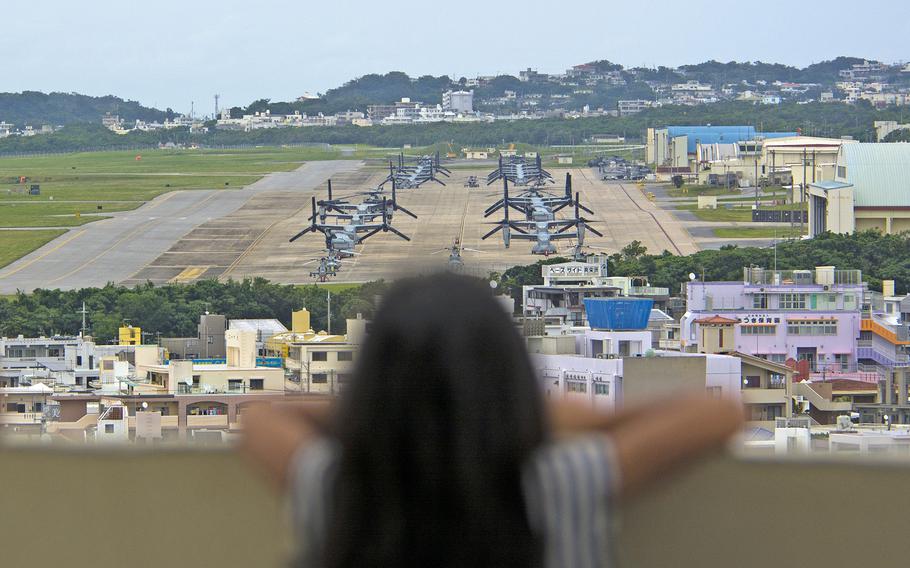
A child looks out at aircraft, including MV-22B Ospreys, at Marine Corps Air Station Futenma, Okinawa, April 19, 2019. (Stars and Stripes)
CAMP FOSTER, Okinawa — Protesters seeking to expel a controversial tiltrotor aircraft from Okinawa plan to rally outside Japanese government offices less than a week after an Air Force Osprey crashed in southwestern Japan.
Led by the anti-base movement All Okinawa, demonstrators will gather at 11 a.m. Monday outside the Okinawa Defense Bureau in Kadena town, group director Yuji Fukumoto said by phone Friday. The bureau represents Japan’s Defense Ministry on the island.
Organizers expect up to 300 protesters from various groups to turn out, Fukumoto said. They want the U.S. military to ground the helicopter-plane hybrid until the accident’s cause is identified.
“If the U.S. side refused to suspend Osprey flights, the Japanese government, as a sovereign nation, must request the withdrawal of the Ospreys from the standpoint of ensuring the safety and security of the Japanese people,” he said.
A CV-22B — stationed at Yokota Air Base in western Tokyo and assigned to the 353rd Special Operations Wing — was on a routine training mission off Yakushima, an island in Kagoshima prefecture, when it went down, according to Air Force Special Operations Command.
“The cause of the mishap is currently unknown,” the command said in a statement released several hours after the incident.
One of the Osprey’s eight crewmembers, Staff Sgt. Jacob “Jake” Galliher, 24, of Pittsfield, Mass., was found unconscious soon after the crash and later declared dead; the search for the remaining crew is ongoing.
The Japan Ground Self-Defense Force has grounded its fleet of 14 Ospreys, and Tokyo has asked the U.S. military to confirm that all its tiltrotors are safe before flying them in Japan.
U.S. Ospreys are still operating in Japan, Pentagon spokesman Sabrina Singh told reporters at a news briefing Thursday in Washington.
Japanese Defense Minister Minoru Kihara said he met with the commander of U.S. Forces Japan, Air Force Lt. Gen. Ricky Rupp, Thursday afternoon at the ministry’s Tokyo headquarters.
“Given that Ospreys continued flights at Marine Corps Air Station Futenma, I once again requested him to provide specific information on the measure that U.S. forces are currently taking and plan to take in order to ensure flight safety,” Kihara said at a news conference after their meeting.
USFJ did not immediately respond Friday to emails and phone calls requesting comment about the meeting.
The Osprey has been a point of contention in Japan since it first arrived at Marine Corps Air Station Iwakuni, near Hiroshima, in July 2012. The aircraft’s development history, coupled with several high-profile crashes, has made it the target of Okinawa’s protest movement.
Three Marines died in Australia on Aug. 27 when their Osprey crashed during the multinational Talisman Sabre exercise.
Another five died in a June 2022 crash in the Southern California desert, an incident tied to an ongoing mechanical problem — a hard clutch engagement — in the gearbox, according to a Marine Corps accident investigation.
In the hours after Wednesday’s crash, Okinawa prefecture reached out to the Okinawa Defense Bureau and the Ministry of Foreign Affairs to request that Ospreys be grounded until an investigation is completed, a spokeswoman from the prefecture’s Military Base Affairs Division said by phone Thursday.
It’s customary in Japan for some government officials to speak to the media on condition of anonymity.
“Ospreys are confirmed to be flying in Okinawa even today and it is highly regrettable,” Okinawa Gov. Denny Tamaki wrote Thursday in a post on X, formerly Twitter. “I have serious doubts about using Ospreys when the accident’s cause is unclear.”
Tamaki sent another request to a Foreign Affairs’ liaison and the defense bureau on Friday, the military affairs spokeswoman said.
Stars and Stripes reporters Hana Kusumoto and Alex Wilson contributed to this report.